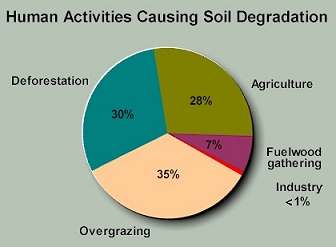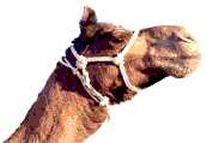Soil erosion
Introduction
Soil is one of our most precious resources. The loss of this resource, through land degradation processes such as wind and water erosion, is one of the most serious environmental problems we are faced with as it is destroying the means of producing our food.

Soil erosion is a natural process and has occurred throughout geological history. Human activities, particularly agriculture and deforestation, however, have increased erosion rates, as they tend to remove the protective vegetation and reduce the stability of the soil. This human influenced process is termed accelerated erosion. Since 1950 accelerated erosion has resulted in the loss of 1/5 of the topsoil from the worlds agricultural land and 1/5 of the topsoil from tropical forests.
A United Nations study has found that 10.5 per cent of the planet's most productive soils - an area the size of China and India combined - have been seriously damaged by human activities since World War II. As many as 9 million hectares of arable land have been irreversibly damaged by overgrazing, deforestation and unsustainable agricultural practices. A further 1.25 billion hectares is considered to be seriously degraded and could be restored, but only at great cost.
It has been estimated that total global soil erosion costs agriculture many hundreds of billions of US dollars every year. This includes the cost of water treatment, dredging of waterways and lost food production, but does not include damage to aquatic ecosystems or the value of the soil itself.
Just how long soil losses can be tolerated before soil productivity is significantly affected depends very much on soil depth. On deeper soils regular erosion losses may be maintained for 100 to 200 years without any obvious loss of productivity, however any regular loss of soil in excess of natural replacement rates is unacceptable as it means that significant damage is being done to one of our primary assets - the soil.
What you can do?
Support organic farming by purchasing organic foods and encourage your local retailer to stock organic produce.
If you are a farmer, you can conserve your soil resources by using conservation tillage techniques to reduce soil disturbance and compaction and by reducing stocking rates to limit soil compaction. However, the best way to reduce erosion is by making sure the soil is covered by vegetation as much as possible. You can achieve this by revegetating areas of your farm with native trees and understorey plants, leaving crop stubble in place after harvesting and by including cover crops or pasture in your cropping rotations.

Map showing the areas around the world that are subjected to erosion and desertification
History
Accelerated erosion is not a recent problem. Since the advent of agriculture 10 000 years ago, most areas of the world have sustained soil damage from erosion. Land degradation, including erosion, is thought to be responsible for the collapse of ancient civilisations and some more recent ones.
Mesopotania, which stretched across modern-day Syria and Iraq, maintained a progressive civilisation from approximately 4000 BC to the mid 1200's AD. Its decline is believed to be related to erosion caused by deforestation and overgrazing in the Armenia highlands in eastern Turkey.
In 1550, approximately 7000 people lived on Easter Island in the Pacific Ocean. Only 300 years on, in 1850, due to deforestation and the resulting collapse of the natural and agricultural systems on the island, the population fell to 100 people.
Wind and water erosion

Water erosion results from the action of rainfall on the soil surface - either from the direct impact of raindrops or from the flow of water across the ground (called runoff).
The severity of water erosion is affected by the condition of the soil surface, the slope of the land and how much vegetation covers the soil surface. Vegetation cover is the most significant factor determining the severity of water erosion. Therefore, any human activity that removes or decreases vegetation cover can cause erosion, for example deforestation, widespread cropping and overgrazing.
Other forms of land degradation, such as salinity, waterlogging, soil compaction and water repellence, can also cause water erosion because these problems:
Wind erosion is caused by the action of the wind on the soil surface and is the process by which fine soil particles are carried away. Wind erosion is a serious problem in many parts of the world, especially in arid and semi-arid regions. It affects agricultural land in much of northern Africa and the Near East, parts of southern, central and eastern Asia, Australia, north west China, southern South America and North America.
The severity of wind erosion is influenced by wind speed, the condition of the soil surface and the amount of vegetation cover present. Like water erosion, wind erosion is significantly influenced by the amount of vegetation cover, therefore any activity that removes vegetation, such as agriculture, deforestation or other land degradation processes, can result in severe wind erosion.
Coastal erosion
Wind, waves and longshore currents are the driving forces behind coastal erosion. Like wind and water erosion, coastal erosion is a natural process however human activity can exacerbate the effects. Activities that can influence costal erosion include:
Environmental consequences and costs
Wind and water erosion

Wind and water erosion remove the nutrient-rich topsoil, therefore one of the most significant effects they have is a reduction in agricultural productivity.
Erosion not only damages the immediate area where it occurs but has negative effects on the surrounding environment. Soil and nutrients, especially phosphorus and nitrogen from agricultural fertilisers, that are transported in estuaries, rivers, lakes and dams cause the most serious off-site damage, for example:
Wind erosion also results in:
Coastal erosion
Coastal erosion has a number of effects on the coastline including threats to lagoons, estuaries and wetlands, a reduction in beach area and damage to developments and roads close to the beach.

What can be done about erosion?
Wind and water erosion
The impact of wind and water erosion on agricultural land and the surrounding environment can be reduced by:
Coastal erosion
The damage caused by coastal erosion can be prevented or reduced by:
Links:
Search our database for the contact details of organizations that directly address Soil Erosion






